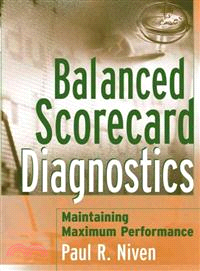The complete guide to analyzing and maximizing a company's balanced scorecard
Presenting the next step for balanced scorecard implementation, Balanced Scorecard Diagnostics provides a step-by-step methodology for analyzing the effectiveness of a company's balanced scorecard and the tools to reevaluate balanced scorecard measures to drive maximum performance. CEOs, CFOs, CIOs, vice presidents, department managers, and business consultants will find all the essential tools for analyzing a balanced scorecard methodology to determine if it's running at maximum performance and for seamlessly implementing changes into the scorecard.
Paul R. Niven (San Marcos, CA) is President of the Senalosa Group, a consulting firm exclusively dedicated to helping businesses get best-in-class performance. He is the author of two successful books, Balanced Scorecard Step-by-Step (0-471-07872-7) and Balanced Scorecard Step-by-Step for Government and Nonprofit Agencies (0-471-42328-9), both from Wiley.
| FindBook |
有 1 項符合
Balanced Scorecard Diagnostics: Maintaining Maximium Performance的圖書 |
 |
BALANCED SCORECARD DIAGNOSTICS 作者:Paul R. Niven 出版社:JOHN WILEY & SONS 出版日期:2005-03-24 規格: / 224頁 |
| 圖書館借閱 |
| 國家圖書館 | 全國圖書書目資訊網 | 國立公共資訊圖書館 | 電子書服務平台 | MetaCat 跨館整合查詢 |
| 臺北市立圖書館 | 新北市立圖書館 | 基隆市公共圖書館 | 桃園市立圖書館 | 新竹縣公共圖書館 |
| 苗栗縣立圖書館 | 臺中市立圖書館 | 彰化縣公共圖書館 | 南投縣文化局 | 雲林縣公共圖書館 |
| 嘉義縣圖書館 | 臺南市立圖書館 | 高雄市立圖書館 | 屏東縣公共圖書館 | 宜蘭縣公共圖書館 |
| 花蓮縣文化局 | 臺東縣文化處 |
|
|
圖書介紹 - 資料來源:博客來 評分:
圖書名稱:Balanced Scorecard Diagnostics: Maintaining Maximium Performance
內容簡介
作者簡介
PAUL R. NIVEN is President of the Senalosa Group, a consulting firm exclusively dedicated to helping businesses reach breakthrough results using the Balanced Scorecard. In addition to publishing articles on performance management in Journal of Cost Management and Journal of Strategic Performance Measurement, he is the author of the highly successful books, Balanced Scorecard Step-by-Step: Maximizing Performance and Maintaining Results and Balanced Scorecard Step-by-Step for Government and Nonprofit Agencies, both published by Wiley. He may be reached through his Web site at senalosa.com.
|











